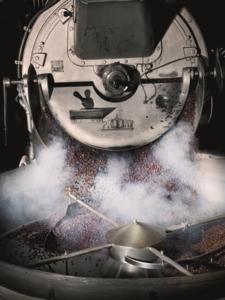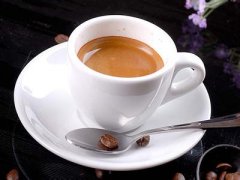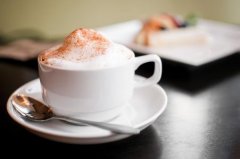Introduction of roaster roaster is mainly divided into four categories
The roaster is mainly divided into four types: direct fire type, semi-hot air direct fire type, hot air type and electric type.

1. Direct fire type
Direct fire is the earliest baking tool, that is, raw beans are roasted in a hot drum and then transferred to the cylinder. The built-in motor keeps running the drum and stirring the coffee beans in the drum, trying to make each coffee bean come into contact with the hot iron evenly to achieve the goal of balanced roasting.
Disadvantages:
The heat conduction rate of ● metal is not fast enough, so it takes more time to preheat the drum.
● burns the outside of the drum, but the heat dissipates in the air, so it's a pity that it can't be used well.
● when the raw bean touches the inner wall of the drum for too long, it is easy to scorch, resulting in bitterness and scorching taste.
The silver film or silver skin produced by ● during baking will be left in the tube, which is easy to attach to the surface of coffee beans and make the flavor cloudy.
two。 Semi-hot air direct fire type
Between 1870 and 1920, the German Fan Guban improved and manufactured the barrel roaster. In his baking theory, he refers to coffee beans that bring hot air into roasting. In 1907, the German-made Perfekt roaster began to introduce this concept, using gas heating, there is an air pump, half of the hot gas into the drum, half to the outer barbecue drum. Up to now, roller baking in Germany is still widely used, and the country's Probat drum roaster is famous all over the world.
The general roaster uses gas or electricity as the heat source. In 1987, Derek Company of Idaho took the lead in using the infrared heat source activated by gas, which made the temperature control more accurate and well received, and became the first brand in North America.
Today's drum roasters are almost all semi-hot air direct fire type, on the one hand directly heat the drum with the fire source, on the other hand bring the hot air into the drum. The hot air blown into the drum can increase the heating speed and blow away the debris, thus producing balanced and clean coffee beans.
3. Hot air type
In the 20th century, some people thought of using hot air to bake coffee beans. In addition to using hot air to bake coffee beans without iron barrier, the heat source can be transmitted directly to raw beans to improve baking efficiency. The Thermonro roaster JadezBurnsThermalo made by Burns Company in the United States in 1934 is a kind of hot air type machine. There are still some large baking plants in the United States and are still using this kind of roaster.
In addition, the wind bed roaster Fluid-BedRoaster can still be seen in the market. Here can be briefly introduced: the structure of the hot air baking machine still adopts the drum design; the raw beans are turned by rolling to achieve balanced baking. In 1976, American Michael. Schweitz MichaelSivetz designed the air bed roaster Fluid-BedRoaste, which allows air to blow up and down in an airtight container, allowing raw beans to float up and down until the baking is completed, and then poured into the cooling tray outside the container to cool.
4. Electric heating type
Electric heating type is the electric heating wire heating drum, this kind of power is relatively large and better electricity, the disadvantage is that the electric heating pipe for a long time value voltage instability will lead to damage, the loss of heating function, the equipment will be paralyzed. In fact, do not worry too much, almost every city's electrical wholesale market can be customized heating tube, so that the machine back to work.
Important Notice :
前街咖啡 FrontStreet Coffee has moved to new addredd:
FrontStreet Coffee Address: 315,Donghua East Road,GuangZhou
Tel:020 38364473
- Prev

The explanation of Coffee Common sense about the degree of Coffee Baking
First, when studying the roasting degree of coffee beans, the degree of roasting can be judged by sound, color and aroma. Its color ranges from light gray to dark brown, and its aroma is gradually rich from light and elegant; the sound is made two times of bursting sound. Taking the heat-resistant raw bean as an example, the first explosion begins at about 7 minutes and lasts for about 2 minutes, and its voice is low. It indicates the beginning of pyrolysis, the conversion of starch to caramel and water steaming.
- Next

COE Cup of Excellence, a boutique coffee rating system
Cup of Excellence, referred to as COE, is a boutique coffee rating system. The origin of the Cup of Excellence system: the reason why producers have the motivation to grow high-quality coffee is not just for me to grow delicious coffee! This kind of self-consciousness, but also have high profits. Therefore, there is a high-quality coffee evaluation meeting, using the COE system, according to the score evaluation ranking. Frequency of COE
Related
- Beginners will see the "Coffee pull flower" guide!
- What is the difference between ice blog purified milk and ordinary milk coffee?
- Why is the Philippines the largest producer of crops in Liberia?
- For coffee extraction, should the fine powder be retained?
- How does extracted espresso fill pressed powder? How much strength does it take to press the powder?
- How to make jasmine cold extract coffee? Is the jasmine + latte good?
- Will this little toy really make the coffee taste better? How does Lily Drip affect coffee extraction?
- Will the action of slapping the filter cup also affect coffee extraction?
- What's the difference between powder-to-water ratio and powder-to-liquid ratio?
- What is the Ethiopian local species? What does it have to do with Heirloom native species?

